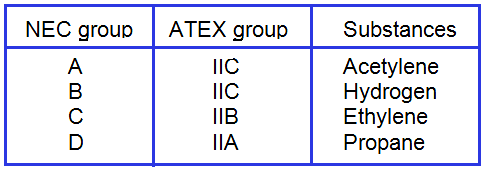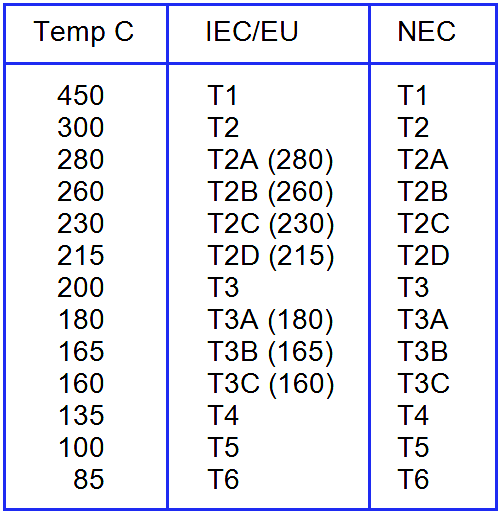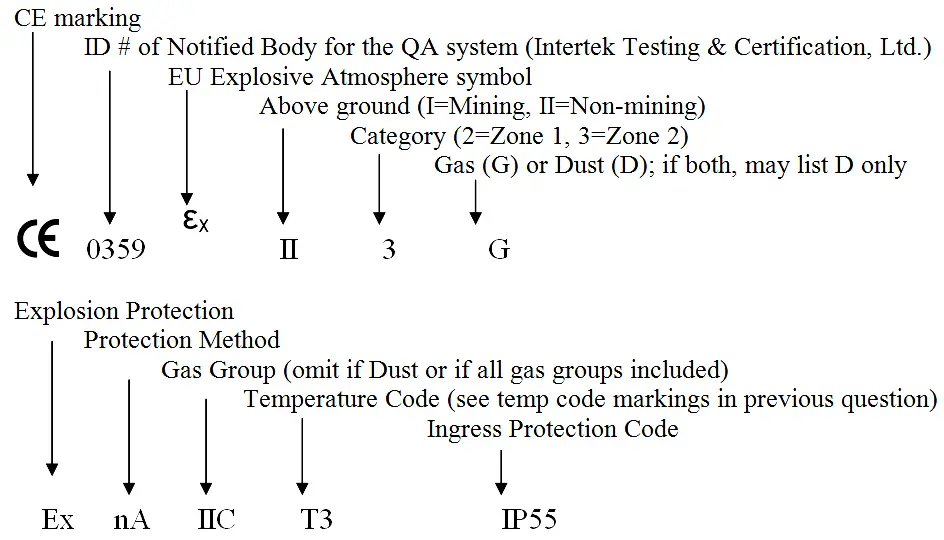What does “ATEX” stand for?
“ATEX” is a French acronym meaning “Atmosphere Explosible”, and encompasses a series of standards pertaining to equipment and personnel within hazardous locations.
What does “Zone 2” mean?
“Zones” refer to a general area classification associated with the likelihood or risk of explosion. This is comparable to “Divisions” used in context of North American NEC (National Electric Code) vernacular. Zone 2 and Division 2 are similar but not identical.
What is the history and scope of ATEX?
ATEX consists of two separate European Directives (by the way, “directive” can be directly translated into “law”…the requirements are not optional), including Directive 1999/92/EC (date of enforcement 7/1/06) governing workplace safety and Directive 94/9/EC (date of enforcement 7/1/03) which deals with equipment such as electric motors placed into potentially hazardous environments. A major objective of ATEX, beyond protection of personnel and equipment, is development of a common European standard, as ATEX is enforced in all 24 member EU countries and their territories, plus Iceland, Norway and Liechtenstein.
How are categories classified?
The broadest category defines both the area and risk of explosion: Area (aka Equipment Group) is defined as “Above-“ or “Below-Ground” (non-mining or mining…mining categories are M1 or M2). Risk is classified into zones, where Zone 0 defines an area in which an explosive atmosphere is continually present and is not applicable to motors, Zone 1 defines an area in which an explosive atmosphere is likely to occur in normal operation occasionally, and Zone 2 defines an area in which an explosive atmosphere is not likely to occur in normal operation, but if it does, only occurs for short periods. Just to make things even more interesting, while Zone 1 or 2 refer to gases, ATEX refers to their dust environments’ counterparts as Zone 21 or 22 respectively.
What is “Equipment Category”?
Category 1 refers to Zone 0; category 2 refers to Zone 1; category 3 refers to Zone 2. This number is combined with a “G” for gas or “D” for dust to complete the equipment category. Thus, a Zone 2 motor suitable for flammable gases (within a defined gas group) would be listed as “3G”. Often, when a motor is suitable for flammable gases and combustible dusts, only the “D” (dust) follows the category number since dust standards are more stringent.
Is there a difference between “Flameproof” and “Explosion Proof”?
A. Generally, there is no difference in construction. The term “Flameproof” (protection type “d”) applies to European standards, whereas “Explosion Proof” is used in NEC standards. Neither of these terms should be misinterpreted that “Flameproof” motors are IEC (metric) and “Explosion Proof” motors are NEMA.
Are “groups” expressed differently in ATEX versus NEC standards?
Yes. But the good news is that each respective group contains the same gas substances.

“Group II” refers to non-mining.
As in the case of “Equipment Category”, the most stringent group is listed.
What about Groups E, F and G?
ATEX defines Groups F and G in a “Zone 21” (“Flameproof”) motor. There are no defined groups for “Zone 22”. There is no such thing as “IIF” or “IIG” within ATEX; these groups are simply designated “D” (for dust) and the appropriate temperature code ensures the motor is placed into the appropriate atmosphere with the associated dust type (coal or grain dust). Metal dusts as defined in NEC Group E are not defined in ATEX. Ignitable flyings and fibers are considered to be a Class III environment. Motors for Class III are not available from Marathon.
What about temperature codes?
Remarkably, temperature codes in the ATEX world have the same meaning as NA (NEC) standards. At one time, the IEC “in-between” codes (e.g. T2A) defined the actual temp (°C) but they have since adopted NEC nomenclature.

What does “Non-Sparking” mean?
Among about a dozen protection methods identified within ATEX (the “protection method” identifies a specific methodology to ensure the motor and surrounding equipment, buildings and personnel remain safe within a defined zone), “Non-Sparking” specifies a design that mitigates the risk of electrical sparking from mechanical or electrical sources. These include the use of conductive (non-sparking) fans, minimum air gap specifications and proper spacing of electrical terminals. “Non-Sparking” is identified as protection type “nA”.
What is a “Notified Body”?
Typically known as an “ENB” (European Notified Body), these are agencies like UL that test products and/or evaluate processes to ensure compliance with all applicable specifications and standards. The ENB then issues a Certificate, confirming that the manufacturer has met all of the ATEX requirements.
Can a manufacturer “self-certify”?
Yes and No. Compliance with Zone 1 requirements must be confirmed by an independent third party (ENB). However, a manufacturer may choose to self-certify Zone 2 equipment. Marathon Electric’s practice has been to utilize a third party for all certifications and we recognize that this provides greater assurance to our customers and greater credibility to us as we develop the market.
What is the minimum IP (Ingress Protection) requirement to comply with ATEX?
Minimum IP54 is required, wherein “5” is the degree of protection against solids (dust) and “4” defines the degree of protection from liquids entering the enclosure. Generally we chose to incorporate IP56 to provide even greater assurance to our customers of the quality and construction of our product offering.
Please explain the temperature code options.
See the following chart

Please explain the nameplate marking requirements

What is the IP Rating System?
The Ingress Protection (IP) rating system is an internationally recognised scale that relates to proven protection against environmental factors such as liquids and solids. Ingress protection ratings can be identified by the letters IP, followed by two numbers. These numbers define the amount of protection a digital scale has against specified elements and its ability to resist foreign matter that could otherwise get inside the product and cause it to fail.
The first number refers to the amount of protection a scale or indicator enclosure has against solid matter (such as dust particles), while the second number defines the level of protection against liquids. The larger each digit is, the greater the protection.
Explain different IP RATINGS SCALE ?
IP Rated Enclosures
First Digit (intrusion protection)
0 No special protection
1 Protection from a large part of the body such as a hand (but no protection from deliberate access); from solid objects greater than 50mm in diameter.
2 Protection against fingers or other object not greater than 80mm in length and 12mm in diameter.
3 Protection from entry by tools, wires etc, with a diameter of 2.5 mm or more.
4 Protection against solid bodies larger than 1mm (eg fine tools/small etc).
5 Protected against dust that may harm equipment.
6 Totally dust tight.
Second Digit (moisture protection)
0 No protection.
1 Protection against condensation.
2 Protection against water droplets deflected up to 15° from vertical
3 Protected against spray up to 60° from vertical.
4 Protected against water spray from all directions.
5 Protection against low pressure water jets (all directions)
6 Protection against string water jets and waves.
7 Protected against temporary immersion.
8 Protected against prolonged effects of immersion under pressure.
In Summary:
IP65 Enclosure – IP rated as “dust tight” and protected against water projected from a nozzle.
IP66 Enclosure – IP rated as “dust tight” and protected against heavy seas or powerful jets of water.
IP 67 Enclosures – IP rated as “dust tight” and protected against immersion.
IP 68 Enclosures – IP rated as “dust tight” and protected against complete, continuous submersion in water.
What is IP69K?
The IP69K rating provides protection against ingress of dust and high temperature, high pressure water – making products with this certification ideal for use in conditions where equipment must be carefully sanitised. In industries such as food processing, where hygiene and cleanliness is paramount, equipment must be able to withstand rigorous high pressure, high temperature washdown procedures.
In many industries, where dust and dirt can be an issue, it is important to ensure that dust cannot penetrate the casing of a product and cause it to fail. The IP69K rating is the highest protection available.
How is the water intrusion test performed?
The water intrusion tests themselves are done by placing the product on a turntable with a rotational speed of 5 ±1 revolutions per minute. The product is then sprayed at close range at a rate of approximately 4 gallons/16 litres per minute with water pressure of between 1160-1450 psi, at a temperature of 176°F/80°C. The nozzle from which the water is sprayed is held between 4 and 6 inches from the product, at a variety of angles. Following this rigorous testing procedure, the product is deemed as having successfully achieved the rating if it completely resists water ingress.
How is the dust intrusion test performed?
Dust intrusion testing is equally demanding. A test unit is placed into a sealed chamber, inside which the pressure is maintained below the surrounding atmospheric pressure by use of a vacuum pump. This test is performed with a maximum depressure of 20 mbar inside the item under test, and with a maximum extraction rate of 60 volumes/hour. For the duration of the test, the chamber is filled with circulating fine dust such as talcum powder. The object of the test is to attempt to draw the dust particles into the test unit within a defined period of time. The protection is deemed to be satisfactory if the unit has completely resisted dust ingress at the end of the test.
Explain IP55, IP66, IP67 standards ?
IP55 : The first ‘5’ in ‘IP55’ means that the product is ‘dust protected’. More specifically: “Ingress of dust is not entirely prevented, but it must not enter in sufficient quantity to interfere with the satisfactory operation of the equipment; complete protection against contact”. The second ‘5’ means that the product is protected against ‘jets’ of water. More specifically: “Water projected by a nozzle (6.3 mm) against enclosure from any direction shall have no harmful effects.”
IP66 : The first ‘6’ means that the product is ‘dust proof’. More specifically: “No ingress of dust; complete protection against contact”. The second ‘6’ means that the product is protected against ‘powerful jets’ of water. More specifically: “Water projected in powerful jets (12.5 mm nozzle) against the enclosure from any direction shall have no harmful effects”.
IP67 : The ‘6’ means the same as above: ‘dust protected. The ‘7’ means that the product is protected in water immersed up to 1 meter. More specifically: “Ingress of water in harmful quantity shall not be possible when the enclosure is immersed in water under defined conditions of pressure and time (up to 1m of submersion).”
Explain 3, 3S, 3X, 3R, 4, 4X NEMA standards ?
3, 3S, 3X : Weather-resistant. Protects against weather hazards such as rain and sleet; used outdoors on ship docks, in construction work, and in tunnels and subways. 3X includes corrosions.
3R : Intended for outdoor use. Provides a degree of protection against falling rain and ice formation. Meets rod entry, rain, external icing, and rust-resistance design tests. In our experience, 3R : provides protection against rain falling vertically but does not protect well in circumstances where water is spraying horizontally as with sprinklers or in windstorms.
4, 4X : Watertight. Must exclude at least 65 GPM of water from 1-in. nozzle delivered from a distance not less than 10 ft for 5 min. Used outdoors on ship docks, in dairies, and in breweries. The 4X model has corrosion resistance.
What is the difference between IP65, IP67 & IP68 ?
The differences between commonly sold IP65, IP67, & IP68 strips are slight, but very important. Using the above chart as a guide, we can see that all strips are protected at the highest level from solids and dust. The variations come with the protection against liquids.
IP65 = Water resistant. “Protected against water jets from any angle”
IP67 = Water resistant plus. “Protected against the events of temporary submersion (10 minutes)”
IP68 = Waterproof “Protected against the events of permanent submersion up to 3 meters”
NEMA Enclosure Standards Questions & Answers
What are the size specifications for NEMA enclosures?
There are no standard sizes for NEMA enclosures. The NEMA 250 standard provides construction and test requirements, but each manufacturer designs their own enclosure.
Can I get NEMA to test my enclosure or provide a listing or certification?
NEMA standards are voluntary. NEMA neither tests products nor certifies that a product complies with a given NEMA standard. A manufacturer can choose to self-certify that the product meets the requirements of NEMA 250 or seek independent third-party verification (testing) that the product complies with the NEMA standard. This decision is based on the requirements of the marketplace, e.g., a test agency listing or mark may be required by a customer.
Can I get labels from NEMA to apply to my enclosures to indicate self-certification?
No, NEMA does not provide labeling.
Can I put a NEMA logo on my product or literature since I am self certifying to the NEMA standard?
No, the NEMA mark is a trademark of the National Electrical Manufacturers Association for its trade association services and publications, and it is to be used solely in connection with designating the National Electrical Manufacturers Association as the source of those goods and services. It is not a certification or conformity assessment mark.
Members of NEMA are entitled to use the NEMA member mark to signify membership in NEMA; however, use of the NEMA member mark must not be in close proximity to marks indicating certification or conformity assessment of specific products.
Everyone is permitted to identify self-certified products as NEMA 4, or NEMA 3R, etc. to signify a particular classification of product both on the product and within literature.
Can I self-certify more than one NEMA type rating on my enclosure?
Enclosures that meet the requirements for more than one type rating may be designated by a combination of type numbers, the smaller number being given first. The designation may include a combination of indoor, outdoor, hazardous location, and non-hazardous location ratings if they apply.
Which NEMA types correspond to environmental descriptions such as rainproof, driptight, dusttight, wet location, etc.?
NEMA does not cross-reference the type ratings with these environmental descriptions; however, NFPA 70 National Electrical Code has definitions and in some cases cross references for these descriptions.
Is there a cross reference between NEMA types and IEC 60529 IP ratings?
It is not possible to state that an IP rating is equivalent to a NEMA type designation. An IP rating only considers protection against ingress of solid foreign objects and ingress of water. The NEMA types consider these but also consider other items such as corrosions and construction details. For this reason, it is possible to say that a NEMA type is equivalent to an IP rating, but it is not possible to state that an IP rating is equivalent to a NEMA type.
Is it necessary to field test an enclosure that has openings that are intended to be closed at installation with the fittings in place, such as a conduit connection?
The fittings are to be independently tested to a type number equal to or better than the enclosure type rating on which they are intended to be installed. The assembly of the enclosure with the fittings installed is not required to be field tested.
I have several enclosures that I want to wall mount by drilling through the back and then sealing around the mounting holes with silicon. Is this an acceptable method?
NEMA 250 states that a number of type rated enclosures require a mounting means external to the equipment cavity unless an intermediate bracket or foot is used. The final installation is always subject to the approval of a local inspector.
Are NEMA enclosures rated for arc flash?
No, NEMA 250 does not address arc flash. Arc flash protection requirements are described in NFPA 70E Standard for Electrical Safety in the Workplace. NFPA 70E requires protective equipment and clothing if the operator intends to open an electrical enclosure containing voltage greater than 50 Vac. There are no tests specified in either NEMA 250 or NFPA 70E that rate an enclosure’s resistance to arc flash energy.
Hi,
1. Is self certification for IP class boxes acceptable in India? If so what documents need to be produced?
2. Certification or stamping of which agencies are authorized / acceptable for IP certification in India?